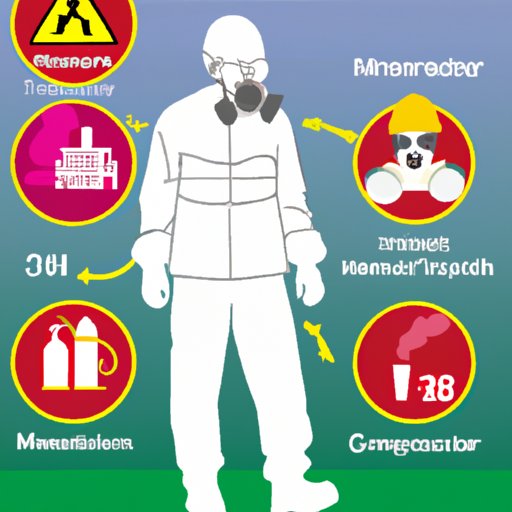Introduction
Health hazards are defined as any type of risk that could potentially damage an individual’s physical or mental wellbeing. These hazards can range from environmental risks to occupational exposures to chemical substances, and they can have both short-term and long-term effects on a person’s health. In this article, we will explore what health hazards are, how to identify them, and what preventive measures can be taken to help reduce their impact.
Identifying Common Health Hazards
Health hazards come in many forms, and it is important to understand the different types and what they can do to your health. Environmental risks include air pollution, water contamination, and physical environment conditions such as extreme temperatures or radiation. Occupational exposures can include hazardous materials, unsafe working conditions, or inadequate safety standards. Chemical substances, such as carcinogens, endocrine disruptors, and neurotoxins, can also put our health at risk.
Examining Long-Term Health Risks
The effects of health hazards can vary depending on the type of hazard and the amount of exposure. Short-term effects may include headaches, nausea, dizziness, fatigue, or respiratory problems. Long-term effects can be more serious, including chronic conditions such as cancer, asthma, and cardiovascular diseases. It is important to understand how these health hazards can affect us in the long run in order to take the necessary steps to prevent them.
Exploring Environmental Factors
Air pollution is a major environmental factor that can have serious health implications. Pollutants like ozone, carbon monoxide, and particulate matter can enter the lungs and cause respiratory problems such as asthma, bronchitis, and even cancer. Poor air quality can also contribute to heart disease, stroke, and other cardiovascular issues. Water contamination is another environmental factor that can lead to gastrointestinal illnesses, skin rashes, and even neurological disorders.

Investigating Occupational Health and Safety
Occupational health and safety is essential for protecting workers from potential health hazards. Employers should ensure that their workplaces are safe and adhere to safety standards. Personal protective equipment, such as safety glasses, gloves, and respirators, should be provided to workers when needed. Regular training and education should also be provided to ensure that workers are aware of proper safety protocols.
Discussing Preventive Measures
Preventive measures are key to reducing the effects of health hazards. Vaccinations can help protect against certain illnesses and diseases, while improved sanitation can help reduce the spread of infectious diseases. Making lifestyle changes, such as eating a healthy diet and exercising regularly, can also help reduce the risk of developing chronic conditions. Additionally, proper disposal of hazardous materials can help protect the environment.
Reviewing Effects of Chemical Substances
Chemical substances can have a variety of adverse health effects. Carcinogens, such as asbestos, can increase the risk of developing cancer. Endocrine disruptors, which are found in plastics and pesticides, can alter hormones and lead to reproductive and developmental problems. Neurotoxins, such as mercury, lead, and arsenic, can damage the nervous system and cause cognitive impairments.

Outlining Strategies to Protect Against Health Hazards
It is important to take the necessary steps to protect ourselves from health hazards. Regular medical exams can help detect any potential health issues early on. Proper disposal of hazardous materials can help reduce environmental risks. Adopting a healthy diet, getting regular exercise, and avoiding smoking and excessive alcohol consumption can help lower the risk of developing chronic health conditions.
Conclusion
In conclusion, health hazards can come in many forms, from environmental risks to occupational exposures to chemical substances. It is important to understand how these hazards can affect our health, both in the short and long term, in order to take the necessary steps to protect ourselves. Prevention is key, and by following preventive measures such as vaccinations, improved sanitation, and lifestyle changes, we can reduce our risk of developing health problems.
(Note: Is this article not meeting your expectations? Do you have knowledge or insights to share? Unlock new opportunities and expand your reach by joining our authors team. Click Registration to join us and share your expertise with our readers.)
